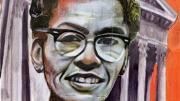As the second world war drew to a close, two women thought about applying to Harvard Law School.
The first was an African-American native of North Carolina, the granddaughter of a slave and the great-granddaughter of a slave-owner, who had moved North for college, survived the lean years of the Depression, befriended Eleanor Roosevelt, and sought unsuccessfully to do graduate work in sociology at the all-white University of North Carolina. When instead she finished Howard Law School at the top of her class, she sought the fellowship traditionally awarded to Howard’s best student: a year at Harvard to complete a master’s of law degree. But, wrote the admissions committee, “Your picture and the salutation on your college transcript indicate that you are not of the sex entitled to be admitted to Harvard Law School.” The woman did not take this rejection sitting down. She was accustomed to standing her ground, after leading some of the first sit-ins for desegregation in the early 1940s and refusing to sit in the back of the bus years before Rosa Parks famously inspired the Montgomery Bus Boycott. After an unsuccessful letter-writing campaign that included supportive intervention from FDR himself, the woman obtained her master’s from Boalt Hall, University of California at Berkeley, and eventually became the first African American to earn a doctorate from Yale Law School.
She went on to play a pivotal role in the history of modern feminism: as a founding member of the National Organization for Women, an American Civil Liberties Union strategist who paved the way for Ruth Bader Ginsburg’s successful litigation campaign for women’s rights before the Supreme Court, a curricular innovator in the study of gender and race as a professor of law and politics at Brandeis, and eventually one of the first female Episcopal priests.
The second woman who thought about applying to law school was a Midwesterner of Scottish descent, educated in Catholic schools paid for by her mother’s hard-earned wages. After politely defying her teachers by declining a full scholarship to a local Catholic college, this woman spent the war acing a full course load in political science at her state’s best university by day, and working eight-hour shifts testing firearms in a munitions factory by night. Upon her graduation, Columbia, Radcliffe, and Wellesley all offered her financial aid for graduate study; she chose correctly, and so impressed her Radcliffe professors that one offered to sponsor her application to law school. The steep cost of a legal education led her to decline, and she was off to Washington to seek a job in the federal government.
During the next several decades, this woman would write several widely read books, earn a law degree at night, and run for Congress twice, all while raising six accomplished children and sustaining a 44-year marriage to a husband who shared and supported her passions. She also launched one of the most successful grassroots movements of the twentieth century, a movement that permanently realigned and transformed American political life.
If these stories sound like far-fetched feminist fantasies, they aren’t quite. The first woman was Pauli Murray, whose remarkable contributions to American legal and women’s history are beginning to be recognized, thanks in large part to the voluminous personal papers she left to the Radcliffe Institute’s Schlesinger Library. The second woman is, quite decidedly and proudly, not a feminist icon. She is Phyllis Schlafly, A.M. ’45, who some say is more responsible than anyone for the rise of grassroots religious conservatism and the transformation of the Republican Party, and who all agree can take the lion’s share of credit or blame for the defeat of the Equal Rights Amendment and the rise of antifeminism as a force in American politics.
What Pauli Murray and Phyllis Schlafly do have in common, apart from compelling and impressive personal histories, is that they both, in their own different ways and to very different ends, sought and exercised power. I want to make just a few tentative observations about how each of these women as women shaped and tried to shape power.
Pauli Murray’s hallmark was always to be two steps ahead of her time. Her simultaneous status as a consummate outsider and an aspiring insider made for a unique perspective from which to identify and fight injustice. As a young woman, she suspected that she might be a man in a woman’s body, noting her attraction to other women and her ambitions, which many considered unfeminine. Though she seems to have reconciled herself to being a woman, her own struggles with gender identity made her especially sensitive to others whose ambitions did not conform to societal expectations.
Murray devoted her career to building bridges between outsider groups otherwise tempted to compete with one another—most importantly for her, between the male-dominated African-American civil-rights movement and the predominantly white women’s movement. Long before it was popular to talk about coalitions and intersectionality and multiple identities, Murray was using her position as a “Negro woman” (as she described herself) to argue for the inclusion of women on the civil-rights agenda and the inclusion of women of color on the feminist agenda. Again and again, she pushed her colleagues to embrace inclusive solutions, not only because a universalist approach was morally right, but also because it was pragmatic. Presciently, Murray recognized that seeking power for one group at the expense of the other would only breed resentment. She maintained this universalist stance, at considerable personal cost, in the face of subsequent criticism from those who favored a more militant and separatist approach.
Just as Murray’s exceptional self-perception and accomplishments led her to seek power for marginalized individuals and groups, Phyllis Schlafly’s mission was also one of antiestablishment empowerment, in its own way. She saw a nation in thrall to weak, communist-sympathizing, effete Eastern liberals, Republican and Democratic alike, who were recklessly sacrificing the values that ordinary God-fearing Americans held dear. Schlafly devoted the first quarter-century of her career to fighting the Eastern liberal establishment within the Republican Party itself, writing not only a widely read hagiography of Barry Goldwater, A Choice Not an Echo, but also numerous articles and books on the need for a strong military defense, and generally championing the ultraconservative wing of the GOP. It was not until the early 1970s that she took up questions of gender and sexuality and declared feminism to be public enemy number one.
Antifeminism served Schlafly well in her quest for power for herself, and, ironically but importantly, empowerment for others. Her status as a woman against feminism bought her enormous cultural and political capital. She could say what a man could not. Moreover, the placement of gender and sexuality, feminism and abortion and gay liberation, religious traditionalism, and family values at the center of conservative politics created powerful alliances possessing a moral force missing from such older conservative cultural causes as the maintenance of racial segregation. Schlafly’s antifeminist crusade drew on very real threats to the male breadwinner/female homemaker model in which so many women as well as men had invested. For these women, a feminism that celebrated women’s accomplishments outside the home, and seemingly threatened wives’ claims on their husbands’ support, was degrading, even terrifying. Schlafly’s grassroots operation gave these women a voice and taught them to use it.
Despite the superficial similarities between Murray’s and Schlafly’s life stories, the contrast between the ends for which they sought power on behalf of themselves and others could hardly have been more stark. But to me, the most striking aspect of these stories is that—despite how far we have come since 1944, when Harvard Law School rejected Pauli Murray and almost certainly would have rejected Phyllis Schlafly—the same questions that animated the contrasting lives of these two women, who came of age in the first half of the twentieth century, are still at the center of our concerns today:
How to mobilize a group as diverse as American women, much less women on a global scale? How to build a society that allows women to do meaningful work for the benefit of their families and themselves, without sacrificing the chance for a rich family life? How to address the very real social and economic dislocations that lead some women to rebel against traditional gender roles and others, defensively or affirmatively, to embrace them? How to harness the benefits of religious faith without imposing contested beliefs on those who do not share them? How to reshape the—for lack of a better term—sexual revolution so that it empowers women and men and children of all orientations without creating additional opportunities for exploitation and inequality? How to build coalitions between groups that share interests but often compete for pieces of a shrinking pie? How to find common ground in an age of outrageous incivility, and avoid the temptation to appeal to fear and prejudice rather than to hope and humanity?
If a world in which even a four-term president of the United States couldn’t convince the president of Harvard to admit a woman to law school seems like a long time ago, these questions seem very present indeed.
Serena Mayeri ’97, a former Harvard Magazine Ledecky Undergraduate Fellow, completed her J.D. degree (2001) and Ph.D. in history (2006) at Yale and is now an assistant professor at the University of Pennsylvania Law School, where she focuses on antidiscrimination law, legal history, and family law and policy. She adapted this essay from remarks she delivered at the Radcliffe Day Symposium last June.
Phyllis Schlafly was scheduled to speak on “The Culture War in the Courts” at the Radcliffe Institute, as part of the Dean’s Lecture Series, on October 15 (after this issue went to press). A report will appear in our next issue.






